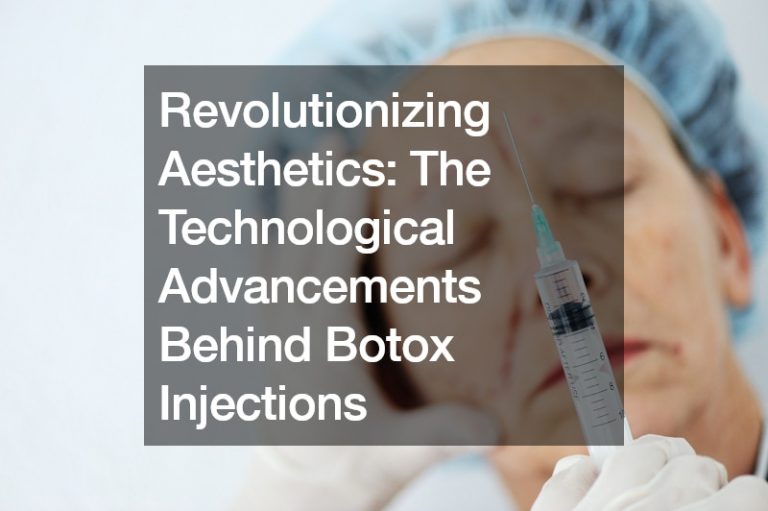For decades, Botox injections have been a popular choice for those seeking to soften wrinkles and achieve a more youthful appearance. But beyond the cosmetic benefits, the science behind Botox is a fascinating story of innovation and technological advancements. This blog delves into the world of Botox, exploring how technology has transformed this injectable treatment from its initial discovery to the cutting-edge techniques used today.
1. From Botulism Toxin to Botox: A Scientific Journey
The story of Botox injections begins with a bacterium called Clostridium botulinum. This bacteria produces a neurotoxin known as botulinum toxin, which can cause a rare illness called botulism.
However, in the 1960s, scientists discovered that tiny, controlled doses of this toxin could have a surprising effect: relaxing overactive muscles.
2. Pioneering Applications: From Strabismus to Wrinkles
The first therapeutic use of botulinum toxin came in the treatment of strabismus, a condition causing misaligned eyes. Ophthalmologists discovered that injecting the toxin into specific eye muscles could relax them, realign the eyes and improve vision.
This discovery paved the way for exploring the use of botulinum toxin for other applications. In the 1980s, dermatologists observed the potential for Botox to address facial wrinkles. Clinical trials demonstrated its effectiveness in relaxing the facial muscles responsible for frown lines and crow’s feet, leading to the FDA approval of Botox Cosmetic in 1989.
3. Refining the Formula: The Evolution of Botox Injections
The early days of Botox injections involved using a crude, unrefined form of botulinum toxin. However, advancements in purification techniques led to the development of a more consistent and safer product.
Furthermore, the introduction of Botox Cosmetic in a pre-diluted form ensured precise and consistent dosing, minimizing the risk of side effects. This standardization also facilitated the development of standardized injection protocols, ensuring optimal results.
4. Precision Injection Techniques: Guiding the Needle
The effectiveness and safety of Botox injections rely heavily on precise needle placement. Technological advancements have played a crucial role in achieving this precision:
Anatomic Mapping: Detailed anatomical maps of the face guide physicians in identifying the optimal injection sites for targeting specific muscle groups and achieving the desired aesthetic outcome. Electromyography (EMG): This technique uses electrical signals to pinpoint the exact location of overactive muscles, allowing for even more targeted injections. Imaging Technologies: Ultrasound or fluoroscopy can be used in some cases to visualize muscle movement and needle placement in real time, further enhancing precision. 5. Personalization Through Innovation: Tailoring Treatment to Individual Needs
The concept of a "one-size-fits-all" approach to Botox injections is no longer relevant. Technological advancements are paving the way for personalized treatment plans:
Botox Dosage Customization: The amount of Botox injected is carefully tailored to each patient’s individual muscle strength, desired level of wrinkle reduction, and overall aesthetic goals. Combination Therapies: Botox injections can be combined with other cosmetic procedures, such as dermal fillers, for a more comprehensive and natural-looking rejuvenation effect. Advanced Formulations: Research is ongoing to develop new formulations of botulinum toxin with varying durations of action. This allows for more flexibility in tailoring treatment plans to individual needs and preferences. 6. The Future of Botox: Emerging Technologies and Research
The field of Botox injections is constantly evolving, with new technologies and research areas on the horizon:
Telemedicine and Remote Monitoring: The rise of telemedicine offers the potential for remote consultations and post-treatment monitoring, increasing accessibility and convenience. Injectable Biomaterials: Scientists are exploring the development of injectable biomaterials that can stimulate collagen production and provide longer-lasting wrinkle reduction than Botox. Neuromodulation Advancements: Research is ongoing to explore using botulinum toxin to treat other medical conditions, such as chronic migraines and excessive sweating. 7. Beyond Aesthetics: The Therapeutic Potential of Botox
Botox injections have applications beyond the realm of aesthetics. They are used to treat a variety of medical conditions, including
Chronic Migraines: Botox injections can effectively prevent or reduce the frequency and severity of chronic migraines. Cervical Dystonia: This condition causes involuntary head and neck movements. Botox injections can relax the overactive muscles, relieve pain, and improve quality of life. Hyperhidrosis: Botox injections can significantly reduce excessive sweating in areas like the underarms, palms, and soles of the feet.8. Safety and Regulation: Ensuring Patient Well-Being
As with any medical procedure, safety is paramount with Botox injections. Here’s how technology and regulations play a crucial role:
FDA Regulation: The FDA closely regulates the manufacturing, testing, and marketing of Botox Cosmetic. This ensures that the product meets stringent safety and efficacy standards. Physician Training: Only qualified and trained physicians are authorized to administer Botox injections. They undergo specialized training to understand the anatomy of the face, proper injection techniques, and potential side effects. Informed Consent: Patients considering Botox injections receive detailed information about the procedure, including potential risks and benefits, before consenting. 9. The Ethics of Aesthetics: Balancing Technology with Natural Beauty
The rise of advanced Botox techniques raises ethical considerations:
Maintaining Natural Appearance: Overuse of Botox injections can lead to a “frozen” or expressionless appearance. Technological advancements should support achieving natural-looking results that enhance, rather than mask, facial expressions. Psychological Impact: It’s crucial to address the potential psychological impact of pursuing an idealized beauty standard through cosmetic procedures. Technology should empower informed decision-making, not fuel unrealistic expectations. 10. Conclusion: A Brighter Future for Botox Injections
From its initial discovery to the cutting-edge techniques used today, technology has played a crucial role in revolutionizing Botox injections. Technological advancements have enhanced this popular treatment’s safety, efficacy, and personalization. Looking ahead, continued research and responsible application promise even more innovative uses for Botox injections, not just in aesthetics but also in the realm of medicine.
.





